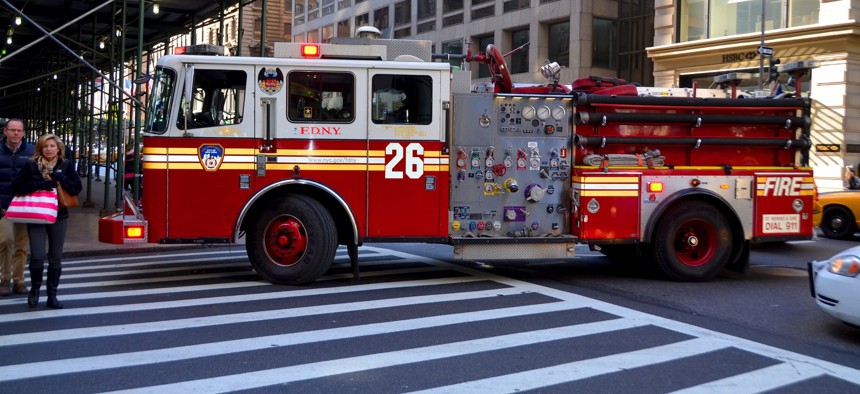N.Y.C. Fire Union Spars With City Over Response Time Metrics

A firetruck in New York City. meunierd / Shutterstock.com
The Uniformed Firefighters Association says the department is prominently displaying “discredited” statistics on its website, while others that show longer average response times are more difficult to find.
A firefighters union in New York City accused the city on Monday of promoting misleadingly low response time statistics for fires and other emergencies.
The criticism was swiftly dismissed by the city’s fire department.
According to the Uniformed Firefighters Association, the Fire Department of New York is featuring “discredited” monthly and yearly response time figures on its website. These statistics, the union says, are based on measurements that start the clock ticking on calls for emergency service when they reach the fire department, as opposed to when 9-1-1 dispatchers answer the phone.
By not factoring in the time between when a dispatcher begins speaking with a caller and when the fire department is alerted, the union contends that average response times shown on the department’s website look seconds, and in some cases minutes, lower than they actually are.
“The numbers the city reports paint a devastatingly inaccurate picture of how long it truly takes for New York City Firefighters to arrive at the scene of an emergency,” Uniformed Firefighters Association President Steve Cassidy said in a statement on Monday.
Under a city statute enacted in 2013—known as Local Law 119—New York’s fire department is required to track the duration of response times, for certain types of fire and medical emergencies, beginning when 9-1-1 operators receive calls for service, and ending when the first fire truck, or ambulance, arrives on the scene of an incident.
But to find the measurements reported under that law through the fire department’s website, a person would have to click a link that says “Local Law 119 Compliance.” Figures showing shorter average response times, based on when the fire department receives calls for service, are available via a link called “Fire Statistics.”
In the union’s view, the link to the Local Law 119 statistics is obscurely labeled and “has no other marker identifying it as the accurate reporting of emergency response times.”
The fire department shot back at the Uniformed Firefighters Association's claims, which were outlined in a news release and a report the union issued on Monday.
“There is nothing misleading about the city’s transparent and detailed reporting on response times for emergencies,” FDNY spokesman Frank Dwyer said in an emailed statement.
Dwyer pointed to the statistics that can be found through the Local Law 119 Compliance webpages.
These pages are housed in a section of the New York City Mayor's Office of Data Analytics website that is devoted to 9-1-1 call performance reporting. Within that section of the website, the response time data can be found under a tab called “Reports.”
Figures accessed through the fire department’s fire statistics webpage show the citywide, average annual response time for structural fires during 2015 was four minutes 11 seconds. In contrast, the Local Law 119 statistics on the Office of Data Analytics website show the average response time for structural fires last year was five minutes.
Between the two websites, the total number of structural fire incidents recorded last year also differs. It is pegged at 27,403 on the fire department page, and at 14,534 on the Office of Data Analytics site.
The Uniformed Firefighters Association represents about 9,000 rank-and-file firefighters in New York City.
Cassidy stressed that seemingly short amounts of time can be critical in an emergency. “If you are trapped in a fire or having a heart attack,” he said, “those crucial seconds and even minutes of extra waiting can mean the difference between life and death.”
Bill Lucia is a Reporter for Government Executive’s Route Fifty. (Photo by meunierd / Shutterstock.com)
NEXT STORY: When Passengers See Transit Investment, ‘Certainly Ridership Does Respond’






